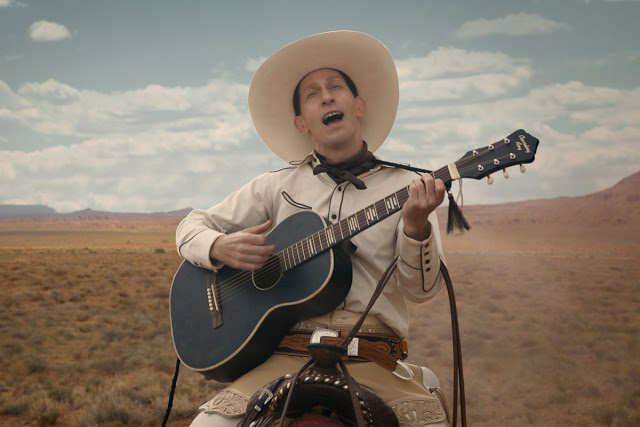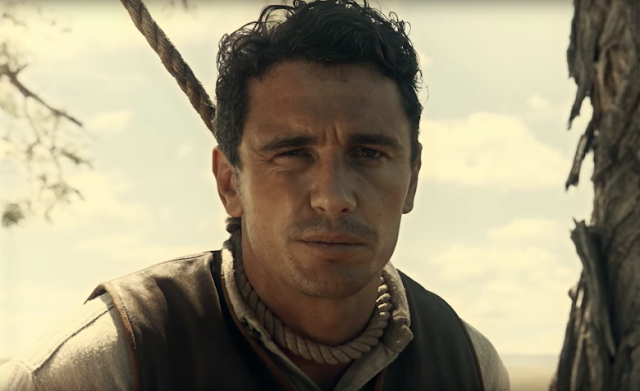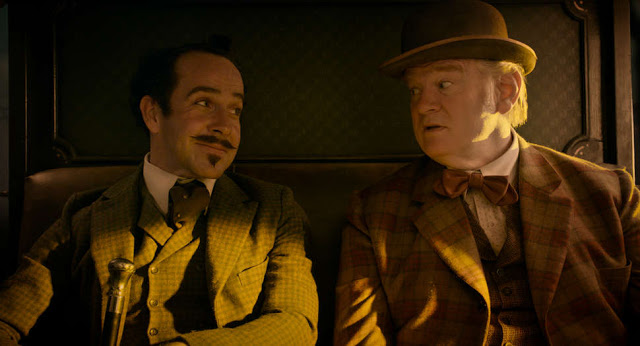In one of the six vignettes that make up The Ballad of Buster Scruggs, the new Western from Joel and Ethan Coen, a solitary prospector played by Tom Waits spends a good deal of time digging a series of holes near a river. As you watch his methodical work, it doesn’t take you all that long to discern his purpose; even if you struggle to fathom the particular mechanics of his strategy, it’s plain that this silent, grizzled man is searching for gold. But because these laborious digging scenes find the film at its least busy—note that this is another way of saying “most boring”—your mind is likely to wander, and to contemplate the potential thematic connections that must surely link the film’s narratively disparate episodes.
But how? In structuring The Ballad of Buster Scruggs as an anthology, the Coens have invited their audience to engage in a robust, somewhat maddening intellectual guessing game. Maybe the movie is about the tragic inevitability of death; this seems plausible, given that four of our six main characters die, while the other two do the killing. Maybe it’s about the inherent tension between the tantalizing promise of the Old West (manifest destiny!) and the cold reality of a lawless, nascent civilization. Maybe it’s about the perpetual collision between man’s insatiable greed—most everyone we meet craves more of something, be it money, glory, or respect—and his desire for stability and peace. Or maybe, just maybe, the vignettes don’t share any deeper meaning at all. Maybe those holes are just holes.
Even if that’s the case, they are some very pretty holes. No strangers to illuminating the sweeping vistas of the American frontier (No Country for Old Men, True Grit), the Coens have once again demonstrated their knack for composing grand, beguiling images that never feel showy or engineered. Shooting in digital (the cinematographer is Bruno Delbonnel, who also shot Inside Llewyn Davis), they routinely deliver pictures that communicate both the beauty and the danger of the West: arid deserts dotted by wilting trees, dusty saloons populated by unsmiling men in dark hats, nighttime campfires that flicker into inky blackness. It’s a lovely world to visit, even if it seems like a lonely place to be.
For a movie that evinces such a fundamentally bleak view of human nature, The Ballad of Buster Scruggs opens with a blast of playfulness and charm. The first segment focuses on our titular troubadour, a smiling outlaw dressed in brilliant white and played with garrulous swagger by Tim Blake Nelson. Where everyone around him is taciturn and cranky, Buster is a jovial chatterbox, eager for company and conversation. But despite his attire and his demeanor, he proves to be a singularly proficient killer, and in a handful of swiftly brutal scenes—a polite request for whiskey in a bar, a poker game that turns into a war of wills, a sunlit duel of vulgar showmanship—the Coens deftly illustrate the absurdly comic possibilities of violence. (One sequence, where a glowering gunman finds his pistol literally turned against him, is particularly inspired, crossing the chilling menace of No Country for Old Men with the zany slapstick of Raising Arizona.) Buster is a larger-than-life figure, which makes the final leg of his journey—where the film suddenly shifts into a fantastical musical—both apt and strangely touching. The single most memorable and dazzling thing about The Ballad of Buster Scruggs is Buster Scruggs.
Once Buster departs the scene and the movie proceeds to its next chapter—the transitions are depicted by a crooked hand turning pages in a book, a device familiar to viewers of the Fargo TV series—it inevitably loses a bit of steam. The three episodes that follow vary considerably in terms of quality, but they are all similarly spartan, minimizing dialogue in favor of a particular mood, which ranges from suspenseful to somber to, er, introspective. In one, a thief (James Franco) holds up a bank, and while his resulting predicament—involving a horse, a noose, and some cowboys and Indians—is amusing, it ultimately leads nowhere beyond an (admittedly very funny) punch line. (It’s also a rip-off of Maverick.) More unsettling, if less entertaining, is the segment in which a traveling barker (Liam Neeson) employs a limbless scholar (Harry Melling, better known as Dudley Dursley) who can recite Shakespeare and Shelley from memory; although the impresario looks after his helpless charge (advertised on posters as “The Wingless Thrush”), their partnership is commercial rather than fraternal, a truth that yields a climax of terrible clarity. And the fourth chapter, featuring Waits as our extraordinarily patient prospector, exemplifies the worst of both worlds, too slow to be intriguing and too opaque to be affecting.
Only in its fifth episode, “The Gal Who Got Rattled,” does The Ballad of Buster Scruggs fully realize its potential, telling a story with actual characters, a crisply developed plot, and real dramatic stakes. It is also the only chapter centered on a woman. That would be Alice (Zoe Kazan, wonderful), a timid young thing whose brother has promised her to his unseen business partner. They’re traveling by wagon train (fire up your Oregon Trail references), and Alice strikes up a tentative friendship with Billy (Bill Heck), a handsome gunslinger assigned to safeguard the train along with Mr. Arthur (Grainger Hines, channeling Jeff Bridges from True Grit). The gender politics on display are somewhat stereotypical, given that Alice is a fair maiden who relies on the benevolent protection of a strapping man. But as the wagons plod along and obstacles continually pop up, the Coens, with energy and economy, weave a tale of decency, surprise, and sadness. Unlike the other segments, “The Gal Who Got Rattled” is genuinely sweet, and that tenderness renders its tragedy legitimately poignant.
I can’t quite say the same for The Ballad of Buster Scruggs as a whole. It’s a technically impressive, easily enjoyable movie that struggles to amount to more than the sum of its literal parts. (The final chapter, set inside a crowded coach where one passenger is played by Brendan Gleeson, is the least dynamic and the most talky; it’s fine.) In choosing the anthology format, the Coen Brothers clearly wanted to say something about the state of cinema in the age of binge-watching and superhero saturation; perhaps that’s why Melling’s literary savant finds himself performing in front of smaller and smaller crowds. But that implication leaves a sour, accusatory aftertaste, as though the Coens are wagging their fingers at their viewers for failing to appreciate their artistry. Perhaps I’m one such numbskull, given that I’m unable to perceive any Deep Meaning in the film, any intricate latticework that invisibly binds the various episodes. But I instead choose to liken myself to that gnarled hand which we briefly glimpse turning the volume’s figurative pages. I consumed The Ballad of Buster Scruggs greedily, and with few regrets. And then, upon turning the final page, I did not hesitate to promptly return the book to its shelf.
Jeremy Beck is the editor-in-chief of MovieManifesto. He watches more movies and television than he probably should.




